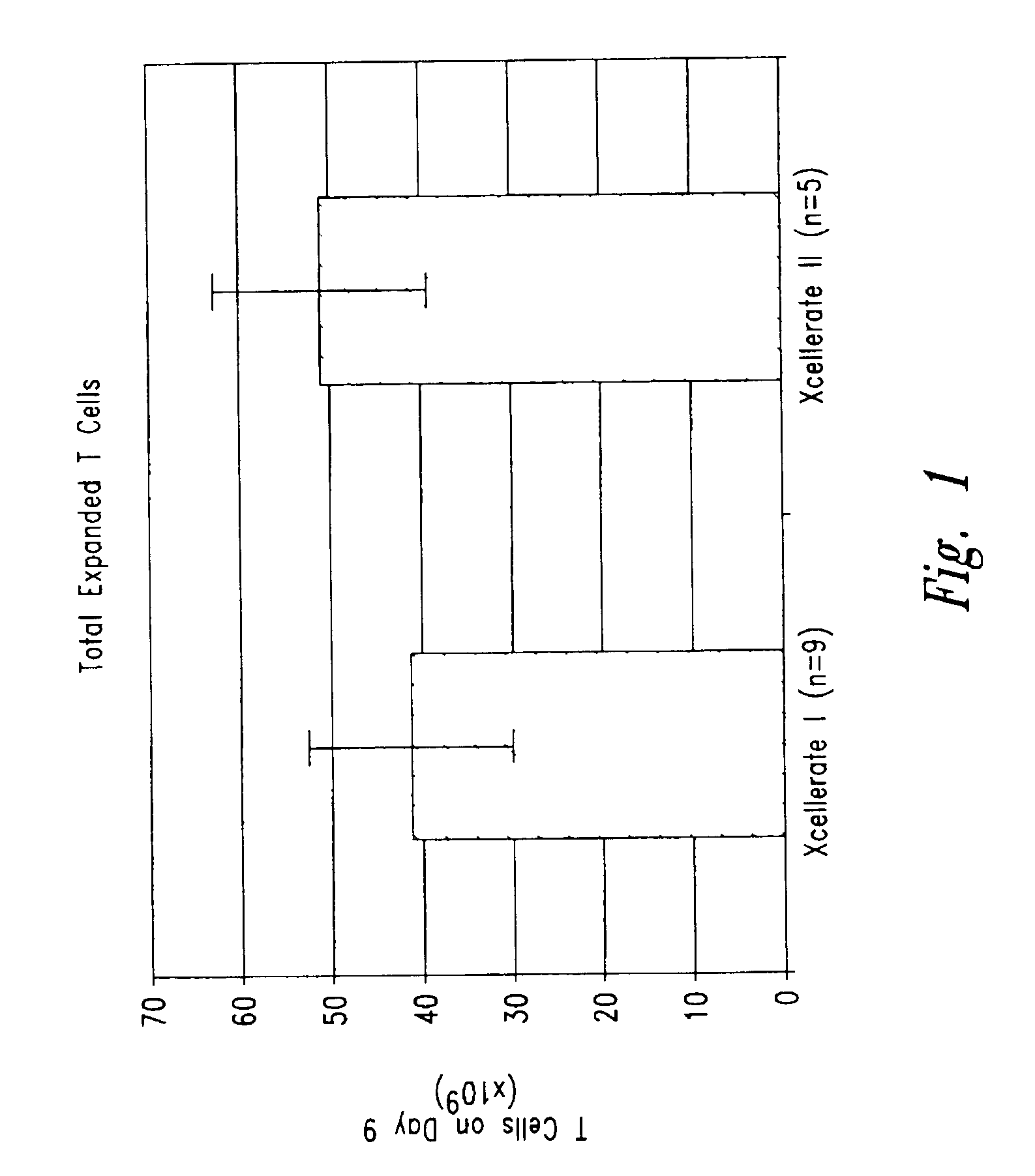Simultaneous stimulation and concentration of cells
a cell and simultaneous stimulation technology, applied in the field of simultaneous stimulation and concentration of cells, can solve the problems of contaminating the entire t-cell population during long-term culture, affecting the stability of t-cell growth, and reducing the efficiency of t-cell growth, so as to achieve the effect of maximizing the stimulation of such cells
- Summary
- Abstract
- Description
- Claims
- Application Information
AI Technical Summary
Benefits of technology
Problems solved by technology
Method used
Image
Examples
example 1
[0171]In certain experiments described herein, the process referred to as XCELLERATE I™ was utilized. In brief, in this process, the XCELLERATED T-cells are manufactured from a peripheral blood mononuclear cell (PBMC) apheresis product. After collection from the patient at the clinical site, the PBMC apheresis are washed and then incubated with “uncoated” DYNABEADS® M-450 Epoxy T. During this time phagocytic cells such as monocytes ingest the beads. After the incubation, the cells and beads are processed over a MaxSep Magnetic Separator in order to remove the beads and any monocytic / phagocytic cells that are attached to the beads. Following this monocyte-depletion step, a volume containing a total of 5×108 CD3+ T-cells is taken and set-up with 1.5×109 DYNABEADS® M-450 CD3 / CD28 T to initiate the XCELLERATE™ process (approx. 3:1 beads to T-cells). The mixture of cells and DYNABEADS® M450 CD3 / CD28 T are then incubated at 37° C., 5% CO2 for approximately 8 days to gene...
example ii
Efficiency of CD3+ T-cell Enrichment, Monocyte-depletion and Granulocyte-depletion
[0190]For this study, upon receipt at the Xcyte Therapies Development laboratory, the incoming PBMC apheresis product was washed, split and:
[0191]1. For the XCELLERATE I process, a monocyte-depletion step was carried out and the CD14+ monocyte-depleted PBMC were cryopreserved and stored in the vapor phase of a LN2 freezer (as noted in Example 1). On the day of set-up of the XCELLERATE I process, the CD14+ monocyte-depleted PBMC were thawed and the XCELLERATE process initiated with DYNABEADS M450 CD3 / CD28 T as detailed in Example 1. The average cellular composition and the average efficiency of CD3+ T-cell enrichment, CD14+ monocyte-depletion and granulocyte-depletion for the N=5 donors in these initial steps is shown in Table 5.1 and the data for each individual donor is shown in Table 5.2.
[0192]2. For the XCELLERATE II process, the PBMC aphesresis product cells cryopreserved and stored in the vapor ph...
example iii
Monocyte Depletion
[0205]Monocytes (CD14+ phagocytic cells) are removed from T-cell preparations via magnetic depletion using a variety of “irrelevant” (i.e., non-antibody coated or non-target antibody coated) Dynal beads. Depletion was performed by pre-incubating either whole blood after separation in ficol or apheresed peripheral blood with Dynal Sheep anti-mouse M450 beads, or Dynal human serum albumin-coated beads (M450), or with Dynal Epoxy (M450) beads at roughly a 2:1 bead to cell ratio. The cells and beads were incubated for periods of 1-2 hours at 22-37 degrees C., followed by magnetic removal of cells that had attached to beads or that had engulfed beads. The remaining cells were placed into culture alongside un-manipulated cells. Cells were characterized by flow cytometry for cell phenotype before and ater depletion.
PUM
| Property | Measurement | Unit |
|---|---|---|
| diameter | aaaaa | aaaaa |
| time | aaaaa | aaaaa |
| time | aaaaa | aaaaa |
Abstract
Description
Claims
Application Information
 Login to View More
Login to View More - R&D
- Intellectual Property
- Life Sciences
- Materials
- Tech Scout
- Unparalleled Data Quality
- Higher Quality Content
- 60% Fewer Hallucinations
Browse by: Latest US Patents, China's latest patents, Technical Efficacy Thesaurus, Application Domain, Technology Topic, Popular Technical Reports.
© 2025 PatSnap. All rights reserved.Legal|Privacy policy|Modern Slavery Act Transparency Statement|Sitemap|About US| Contact US: help@patsnap.com



